#ballestas islands
Text

#travel#photography#fuji x100v#fujixseries#fujifilm#fun#boat trip#boat#boat tour#las ballestas#ballestas islands#paracas peru#paracas#peruvacation#peru#peruvian#travel photography#travel vibes#travel photo blog#travel blogger#rocks#arch#ocean air#oceancore
91 notes
·
View notes
Text



Islas Ballestas, Perù
Sandro Meier
1 note
·
View note
Photo

The Fool. Art by Alba Ballesta González
22 notes
·
View notes
Text

A tri-spine horseshoe crab kicks up sediment along the muddy bottom of the Pangatalan Island Marine Protected Area in the Philippines. After a decade of restoration work to the islet’s bay, its green waters are rich with plankton and ready to welcome back bigger animals.
Dazzling Photos Show Horseshoe Crabs Thriving in Protected Area
In the Philippines, the tri-spine horseshoe crab has made a home and other species are returning too.
— By Amy McKeever | Photographs By Laurent Ballesta | Published:July 12, 2022 | Saturday 05 August, 2023
Horseshoe crabs are built to last. With spiky tails, shells shaped like combat helmets, and sharp pincers at the end of eight of their 10 legs, these ancient invertebrates have been scuttling along the ocean floor relatively unchanged for some 450 million years.
They managed to survive the asteroid that killed the dinosaurs. Surviving humans may prove more difficult. Like many marine animals, horseshoe crabs are overfished for food and bait, and coastal development has destroyed spawning sites. But they also are collected en masse for their blue blood, which contains a rare clotting agent critical for the development of safe vaccines. The blood may be lifesaving for humans, but its harvest often kills the animals—particularly in much of Asia, where they are drained of all their blood rather than just a portion of it.

A horseshoe crab hides an ecosystem within its shell. The hairlike objects along its body are hydroids—tiny, fuzzy invertebrates related to jellyfish—and there are at least eight shrimps clinging to the crab’s pincers. Horseshoe crabs are relatively unstudied; little is known about how they interact with other species.

A tank-like horseshoe crab pushes itself across Pangatalan’s reef, which has benefited from the planting of mangroves and creation of artificial reefs. Members of the class Merostomata—which means “legs attached to the mouth”—horseshoe crabs are more closely related to spiders and scorpions than to crustaceans.

Tri-spine horseshoe crabs have lost more than half their population in the past 60 years. But on the Philippine islet of Pangatalan, the species is an unexpected symbol of resilience. For years the island’s 11 acres were degraded: trees cut down for timber, mangroves burned for charcoal, and coral reefs overfished with dynamite and cyanide. By 2011 these horseshoe crabs, about 15 inches long, were among the biggest creatures left.
Now a marine protected area, Pangatalan is starting to thrive again. Efforts to restore its reefs and plant thousands of trees have led many animals to return, including rare giant groupers that grow to some eight feet long.
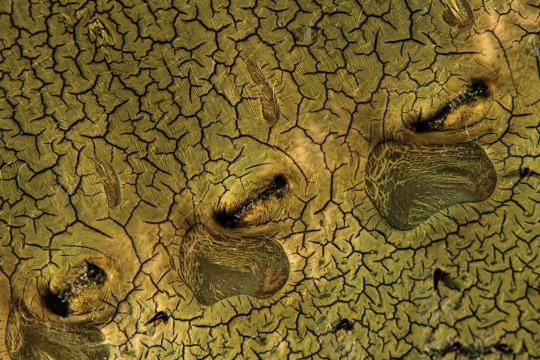
This isn’t an alien landscape—it’s an extreme close-up of the topside of a horseshoe crab’s abdomen. The gills are on the underside, and the dashes and indentations mark where they attach to the exoskeleton. The dark points beneath are minute spines that may function as whiskers do on a cat.
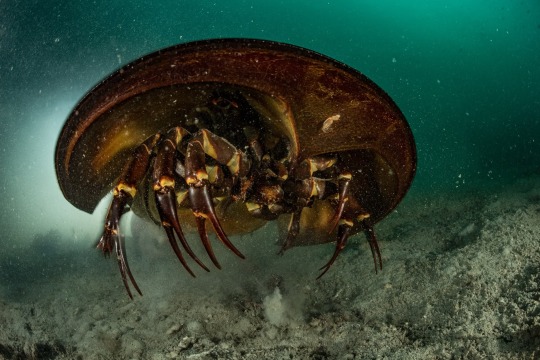
“Be beautiful or be shocking”—these are typical tactics used to get people to care about nature, says photographer Laurent Ballesta. “I think there’s a third way,” he says. “Try to show the mysteries. When you are in front of something you don’t understand, you forget beauty.”
Horseshoe crabs may not be as charismatic as elephants or pandas, but perhaps they’ll inspire people to care more about wildlife. Appreciation for horseshoe crabs has grown thanks to their role in COVID-19 vaccine development. Conservationists hope that regard will translate to stronger habitat protections and wider adoption of a synthetic alternative to crab blood—saving horseshoe crabs just as they’ve helped save us.
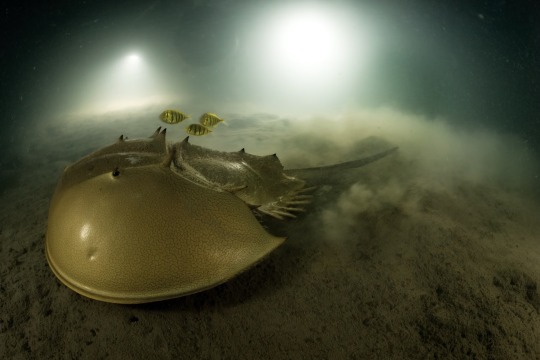
Golden trevallies swim above a horseshoe crab, hoping to catch leftovers as it digs in the mud for clams and other prey. As bigger fish slowly return to the reef, horseshoe crabs may no longer rule the ecosystem. But they remain symbols of its resilience.
— Amy McKeever is a Senior Staff Writer. Laurent Ballesta, named Wildlife Photographer of the Year in 2021, is also a Marine Biologist.
#Photographs#Horseshoe Crabs 🦀#Protected Area#Pangatalan Island Marine Protected Area#Philippines 🇵🇭#Tri-spine Horseshoe Crab#Amy McKeever#Laurent Ballesta#Ancient Invertebrates#Spiky Tails#Shells Shaped | Combat Helmets#450 Million Years Old Species#Asteroid ☄️#Dinosaurs 🦕#Lifesaving For Humans#Ecosystem#Hydroids#Jellyfish#Shrimps#Pincers#Pangatalan’s Reef 🪸#Merostomata: Legs Attached to the Mouth#American: Limulus Polyphemus#Tri-spine: Tachypleus Tridentatus#Mangrove: Carcinoscorpius Rotundicauda#Indo-Pacific: Tachypleus Gigas#COVID-19#Conservationists#Golden Trevallies#The National Geographic
0 notes
Photo






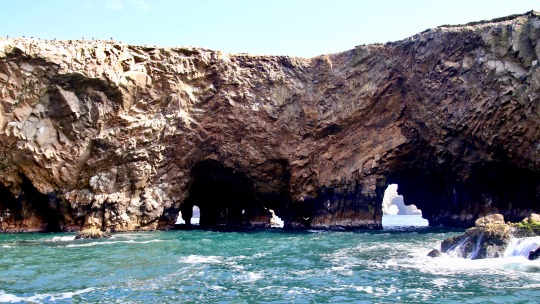



Ballestas Islands ( Peru )
#islaballestas#ballestasislands#paracasperu#paracas#boattrip#boat#pacificocean#southpacific#pacific#ballestas#islands#naturephotography#nature#animals#birds#sealions#penguins#travelphotography#travel#photooftheday#perutrip#gotoperu#peruvisit#perutravel#peru#outdoor#adventure#sea#travelling#traveling
1 note
·
View note
Text

Birds - near Ballestas Islands, 2014
#picofthenight#travel#peru#original photographers#photographers on tumblr#nature#birds#flying#nature photography#photoofthenight
17 notes
·
View notes
Text
¿Anécdotas? Noticias ancianas...

Esta fotografía, capturada en 1974, muestra el descubrimiento inicial de una extensa colección de guerreros de terracota en Xi'an, China-
Lo que hace que esta imagen sea notable es que revela los vívidos colores originales que fueron meticulosamente pintados en estos guerreros de arcilla de tamaño natural hace más de 2000 años por expertos artesanos. Lamentablemente, cuando se expusieron al aire y la luz solar durante la excavación, estos antiguos colores comenzaron a deteriorarse rápidamente y desaparecieron en cuestión de minutos.
Estos guerreros de terracota estaban estratégicamente ubicados para servir como guardianes de la tumba del primer emperador de la China unificada. A día de hoy, la tumba permanece sin abrir.
Según relatos de historiadores antiguos, se cree que la tumba abarca todo un reino y palacio subterráneo, con techos adornados con perlas para simular el cielo nocturno. También se dice que la tumba alberga artefactos extremadamente raros y trampas explosivas con ballestas para disuadir a posibles intrusos. Para salvaguardar el secreto de la tumba, los trabajadores que la construyeron fueron supuestamente enterrados con el emperador.
Sima Qian, un historiador de la dinastía Han, mencionó que dentro de la tumba, "el mercurio se usó para formar los cien ríos, el río Amarillo y el río Yangtze, y los mares de tal manera que fluyeran". Las pruebas modernas han indicado niveles extraordinariamente altos de mercurio en el suelo circundante.
Curiosamente, los registros históricos sugieren que la desaparición del emperador se atribuyó a la ingestión de píldoras de mercurio, que en ese momento se creía que poseían cualidades de un elixir de inmortalidad.
Además, en la imagen contigua, cuando deslizas el dedo hacia la izquierda, puedes observar un primer plano del peinado distintivo de un soldado de terracota, lo que aumenta la intriga de estas antiguas reliquias.
Esta tempestad dejó inmóvil la costa este, depositando nieve de 10 a 58 pulgadas (25 a 147 cm) en varias regiones de Nueva Jersey, Nueva York, Massachusetts, Rhode Island y Connecticut. La fotografía incluida captura a un joven no identificado ubicado dentro de un espacio despejado en Madison Avenue y 40th Street en la ciudad de Nueva York.
El impacto de la tormenta fue de gran alcance: los ferrocarriles cesaron sus operaciones y las personas fueron confinadas en sus residencias por hasta una semana. Las líneas telegráficas y ferroviarias sufrieron interrupciones, lo que motivó la decisión de reubicar estas infraestructuras esenciales bajo tierra.
4 notes
·
View notes
Text
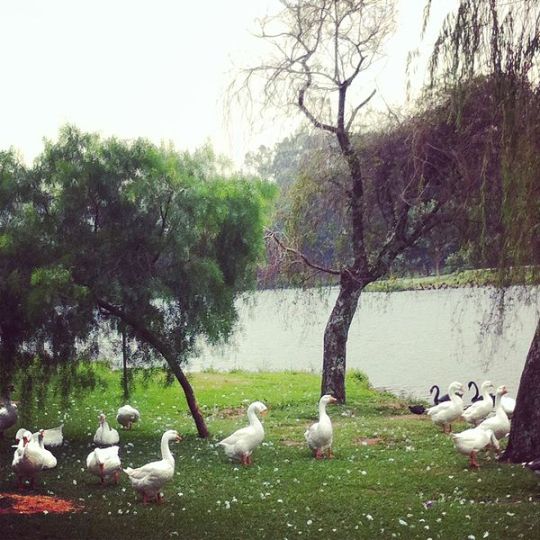


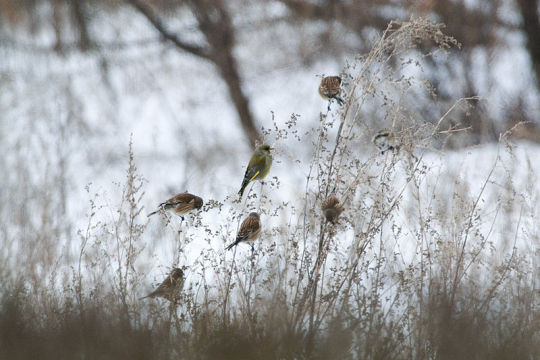
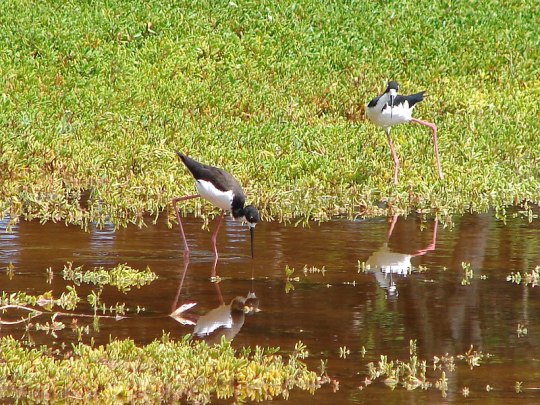
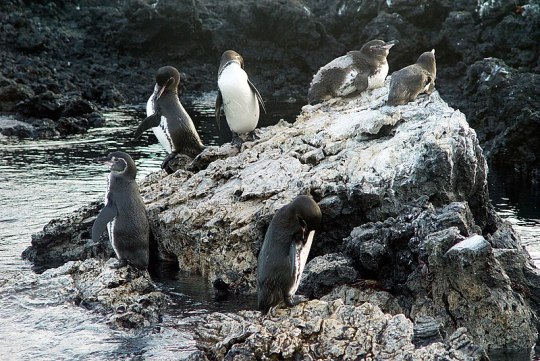
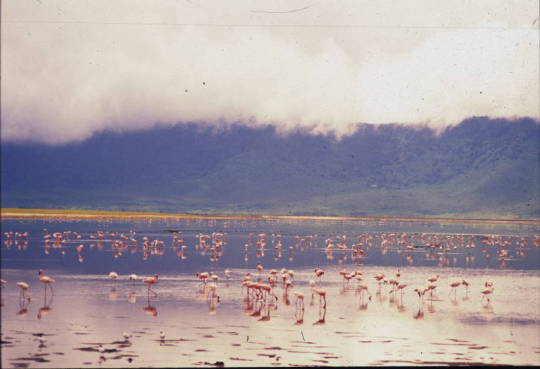
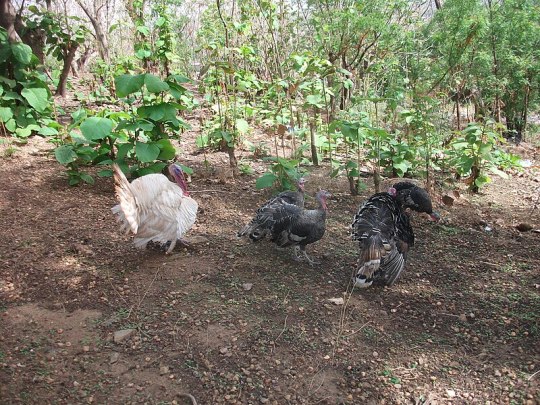

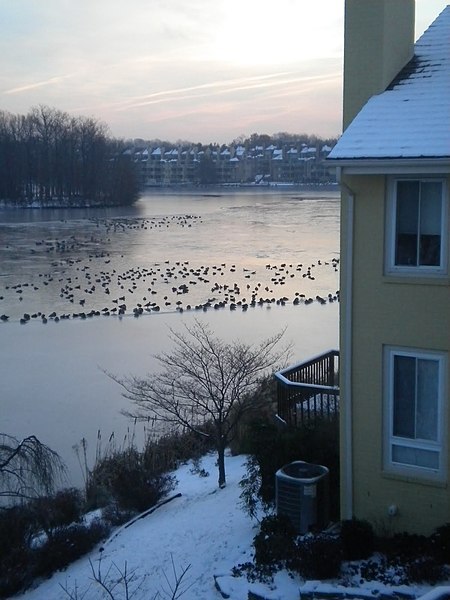
birds in nature compilation
in order:
Parque do Ibirapuera 2.jpg
Ballestas Islands, Peru - panoramio (3).jpg
Starr-080603-5823-Cyperus rotundus-habitat with Laysan albatross-Charlie barracks Sand Island-Midway Atoll (24886448636).jpg
Chaffinch Lodz(Poland)(js)06.jpg
Starr-061021-1312-Sesuvium portulacastrum-habit and stilt-Kanaha Beach-Maui (24774580451).jpg
Spheniscus mendiculus Galápagos Ecuador DSC00320 ed ad.jpg
Phoenicopterus roseus DT -TZ Ngorongoro NP 0202- (2) (20684505199).jpg
DINDE ET DINDON A BASSAR 01.jpg
Starr-150331-1120-Lobularia maritima-habit and Laysan Albatrosses-South Beach Sand Island-Midway Atoll (25245708686).jpg
DSCN0358 (8813402490).jpg
3 notes
·
View notes
Text
Paracas: National Reserve
The original plan for this morning was another relatively early meeting at 7:45am for the boat tour around the Ballestas Islands (also termed the “poor man’s Galapagos”). I’d been looking forward to this tour immensely, especially since a lot of travellers I’d met going towards Cusco had come from Lima and Paracas and commented how much they enjoyed the boat tour. It was a bit of a mad rush to turn in my laundry, pack up my bag to check out, and get to the meeting point down the road. Unfortunately, we were all stuck waiting for updates as the conditions at sea were too rough for the 8am boat tour. I was engulfed in clouds of vape smoke from the dumb British teenagers waiting alongside me. The next boat was at 10am so I had a bit of time to walk out of town up to Mirador San Martin to check out the view, and enjoy a breakfast at Fruzion of some coco Almendras pancakes and a latte. Despite the name and rather disappointingly, the latte was not a latte and just an instant coffee sachet with milk. However the pancakes far exceeded any expectation I had! When I arrived back at the meeting point, the decision had been made that all boat tours were cancelled for the day so unfortunately I was out of luck for seeing the Ballestas Islands. Two buses pulled up and everyone was loaded on in chaos to visit the National Reserve. I ended up sitting next to a guy from Grand Junction, CO who had worked as a ski instructor and patroller within Summit County – small world! It was short-lived though as we played musical buses and he was moved to the other one. Ricardo was our guide and educated us while we drove through the 3,200km2 national reserve. It used to be a forest but is now a desert, actually an extension of the driest desert in Chile, and is home to 120 bird species, foxes, dolphins, and whales. The name Paracas comes from two Quechua words paras and nacos meaning sun and wind storm, presumably based on the weather conditions in this area of Peru! Our first stop was “the cathedral”, a large jagged rock that rose out of the sea separate from the viewing cliff we stood on, followed by the Supay grey sand beach. Supay means demon in Quechua and people would historically commit suicide here as an offering to the gods. It is also a prime earthquake spot, of which they are overdue… Unfortunately the Peru government doesn’t have to restore losses when an earthquake is less than magnitude 8. An 8.2 struck and the president at the time declared it was a 7.9 so they didn’t have to do anything. We reached another photo spot at Yumaque beach, where a dead bird lay amongst the swarm of tourists all crowded on the edge of the cliff for photos. Next was the Istmo peninsula which was like a Mars landscape separating the red beach from the rest of the sandy reserve. There were many large signs saying “don’t pass” and yet almost everyone in the tour group walked all the way out on to the cliff to take photos. I’m glad I followed the signs because staying back meant I could see the guides being berated by some park officials. The officials were taking photos of the guides, and the bus license plates and presumably making threats to kick our whole group out of the reserve for disobeying the signs. At the red beach itself, Ricardo made sure to tell everyone not to pass the signs and barriers before they would let us off the bus. There were some more dead birds lying around here and some dead seals getting picked apart by seagulls. Maybe it was for the best that we didn’t do the boat tour as apparently there were a lot more dead animals out there… On the drive back into town, we were told about the Paracas skulls and a museum we could visit to see them. I didn’t go to the museum but it was interesting how the parents would banadage large rocks to the sides of their children’s heads in order to make their skulls grow upwards to a unique cone shape. On the way out of the reserve we saw a large colony of flamingos and before we knew it we were back in Paracas in time for lunch.
2 notes
·
View notes
Text
Seabirds dive to grab their fish in the waters of the Ballestas Islands. The seabirds include terns, cormorants, and pelicans. There are also grey gulls. They fly to the pelican colony in the beach. It is the largest pelicanry in South America, and is noisy and crowded.
7 notes
·
View notes
Photo

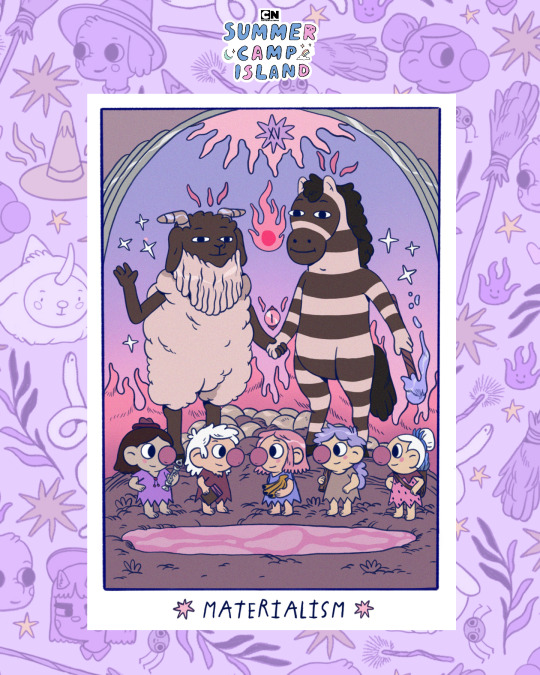

Summer Camp Island tarot cards by Alba Ballesta Gonzalez
2 notes
·
View notes
Text
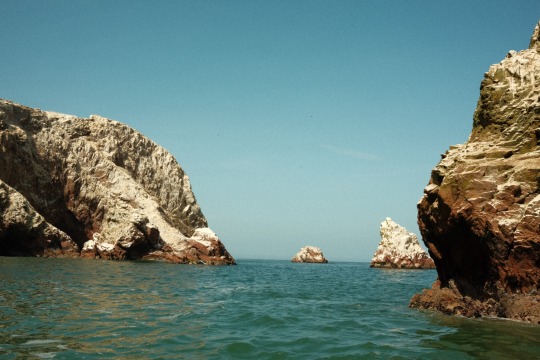
#rocks#ocean core#ocean#sea life#nature#travel#photography#fuji x100v#fujixseries#fujifilm#wanderlust#paracas peru#paracas#peruvacation#peruvian#peru#las ballestas#ballestas islands#ballestas island#boat tour#boat#travel blogger#travel photography#travel vibes#ocean air
10 notes
·
View notes
Text

#travelbookingnow
Immerse yourself in the vibrant tapestry of Peruvian culture and history with Travelbookingnow's Colours of Peru tour.
From the bustling streets of Lima to the ancient ruins of Machu Picchu, this comprehensive 8-day journey showcases the country's most iconic sights and hidden gems. Marvel at the mysterious Nazca Lines, cruise through the Ballestas Islands, and explore the colorful markets of Cusco. Venture into the Sacred Valley and discover the Rainbow Mountain, a natural wonder that will leave you in awe.
With expert local guides and carefully curated experiences, Travelbookingnow ensures an unforgettable adventure that captures the true essence of Peru's colorful spirit.
1 note
·
View note
Photo

The Magician. Art by Alba Ballesta González.
19 notes
·
View notes
Text
Les grands gagnants du concours Wildlife Photographer of the year, organisé par le Muséum d'Histoire Naturelle de Londres
See on Scoop.it - EntomoNews
Le Français Laurent Ballesta entre dans la légende du concours organisé par le Muséum de Londres en remportant pour la deuxième fois ce prix très prestigieux. Le déjà très célèbre biologiste plongeur s’illustre depuis deux décennies par la qualité de ses reportages et photographies du monde marin, nous donnant à découvrir des créatures et des écosystèmes rarement illustrés.
Les photos lauréates du concours Wildlife photographer of the Year 2023 ont été dévoilées - Bourges (18000)
Publié le 15/10/2023 à 16h00
La limule tridactyle
La photographie gagnante [Catégorie : Portfolio Award, ndé] est un portrait d’une limule tridactyle (voir photo ci-dessus), espèce menacée qui vit dans les eaux côtières des Philippines sur des fonds vaseux où elle trouve sa nourriture qu’elle détecte en se déplaçant. Les trois jeunes carangues qui l’escortent sont prêtes à se jeter sur toute source de nourriture qui serait soulevée par le passage de la limule.
Ce cliché tiré d’un portfolio de 6 photographies met en lumière cette espèce [d'arthropode, ndé] méconnue et particulièrement menacée. Son anatomie a très peu changé au cours des âges géologiques puisque l’on retrouve des fossiles très similaires datant de plus de 300 millions d’années. Des efforts de conservation ont permis de limiter les pressions sur les habitats littoraux favorables à cette espèce."
(...)
[Image] "Le cuirassier doré" de Laurent Ballesta, France. Catégorie “portfolio” et lauréat du Grand prix « Photographe de nature de l’année »
-------
NDÉ
Le site du concours
Wildlife Photographer of the Year | Natural History Museum
https://www.nhm.ac.uk/wpy
Grand title winners 2023 :
The Golden Horseshoe, Laurent Ballesta : Adult Grand Title Winner
&
Owls’ Road House, Carmel Bechler : Young Grand Title Winner
L'article du Guardian
→ 2023 wildlife photographer of the year winners – in pictures | Environment | The Guardian, 11.10.2023 https://www.theguardian.com/environment/gallery/2023/oct/11/2023-wildlife-photographer-of-the-year-winners-in-pictures
[...]
The ancient mariner by Laurent Ballesta, France. Winner, portfolio award ‘The golden horseshoe’
A tri-spine horseshoe crab moves slowly over the mud. Its golden protective carapace hides 12 appendages. Above the horseshoe crab, a trio of juvenile golden trevallies are poised to dart down for edible morsels ploughed up by its passage.Portfolio Story: Laurent Ballesta went looking for the crabs in the protected waters of Pangatalan Island in the Philippines. Marine biologist and photographer Laurent Ballesta has dedicated his life to exploring the oceans and revealing their wonder through art. He has led a series of expeditions, all involving scientific mysteries and diving challenges, resulting in unprecedented images. The tri-spine horseshoe crab has survived for more than 100m years but faces habitat destruction and overfishing for food and for its blood, used in the development of vaccines. But, in the protected waters off Pangatalan Island, there is hope for its survival. Location: Pangatalan Island, Palawan, the Philippines
Photograph: Laurent Ballesta/2023 Wildlife Photographer of the Year
0 notes
Photo
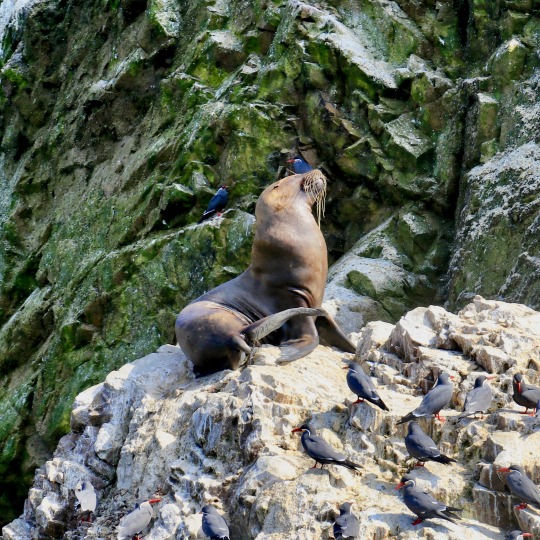
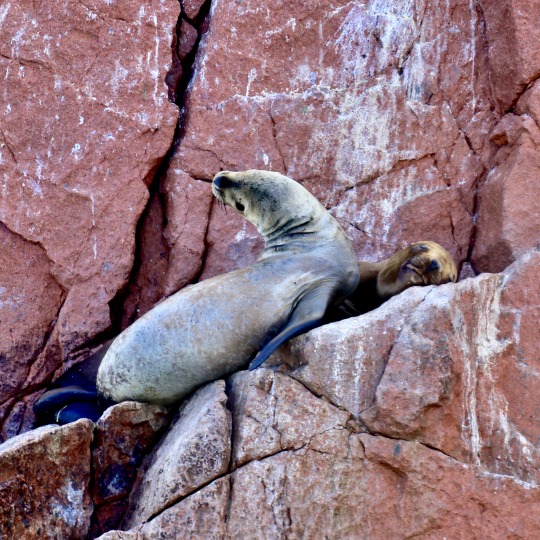






Sea lions ( Ballestas Islands / Peru )
#sealions#islaballestas#ballestasislands#pacificislands#islands#pacific#southpacific#pacificocean#boattrip#naturephotography#nature#perutrip#gotoperu#peruvisit#perutravel#peru#paracasperu#paracas#ocean#sea#animals#rocks#photooftheday#travel#travelphotography#outdoor#adventure#explore#animalsphotography#southamerica
2 notes
·
View notes